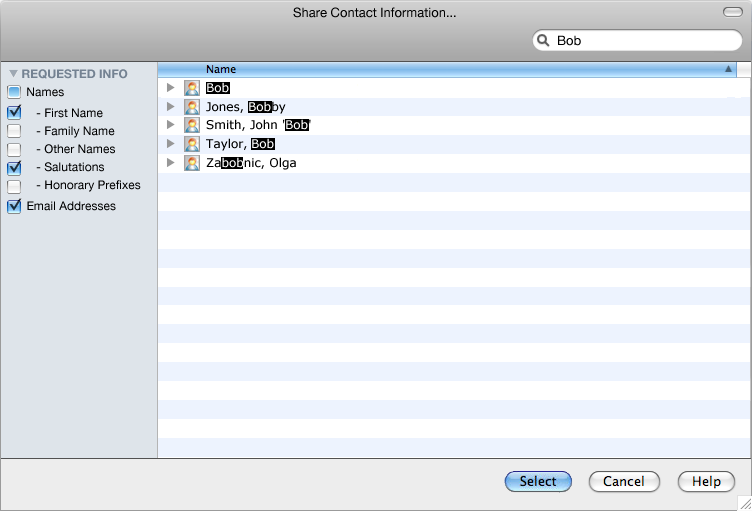Abstract
The Contacts API defines the high-level interfaces required to obtain read access to a user's unified
address book.
This API includes the following key interfaces:
- A
Contacts interface, which provides the method
needed to access a user's unified address book.
- A
Contact interface, which captures the individual
contact information that can be returned following a successful read operation.
Status of This Document
This section describes the status of this document at the time of its publication. Other documents may supersede this document. A list of current W3C publications and the latest revision of this technical report can be found in the W3C technical reports index at http://www.w3.org/TR/.
This document represents the early consensus of the group on the scope and features of the proposed
Contacts API. Issues and editors note in the document highlight some of the points on which the group is
still working and would particularly like to get feedback.
This document was published by the Device APIs and Policy Working Group as a Last Call Working Draft. This document is intended to become a W3C Recommendation. If you wish to make comments regarding this document, please send them to public-device-apis@w3.org (subscribe, archives). The Last Call period ends 14 July 2011. All feedback is welcome.
Publication as a Working Draft does not imply endorsement by the W3C Membership. This is a draft document and may be updated, replaced or obsoleted by other documents at any time. It is inappropriate to cite this document as other than work in progress.
This is a Last Call Working Draft and thus the Working Group has determined that this document has satisfied the relevant technical requirements and is sufficiently stable to advance through the Technical Recommendation process.
This document was produced by a group operating under the 5 February 2004 W3C Patent Policy. W3C maintains a public list of any patent disclosures made in connection with the deliverables of the group; that page also includes instructions for disclosing a patent. An individual who has actual knowledge of a patent which the individual believes contains Essential Claim(s) must disclose the information in accordance with section 6 of the W3C Patent Policy.
3. Security and Privacy Considerations
The API defined in this specification can be used to find contact information from a user's address
books. This discloses information related to a user's contacts such as their phone numbers, email
addresses and other personally identifying information. The distribution of this information could
potentially compromise the user's privacy, or the user's contacts' privacy. A conforming implementation
of this specification must provide a mechanism that protects the user's privacy and this mechanism should
ensure that no contact information is retrievable without the user's express permission.
A. User Interaction Guidelines
This section is non-normative.
This specification is primarily intended to provide the user with the ability to view and control the
contact information that may be shared from their unified address book. This annex provides some examples
of a conformant user experience that this specification enables.
A.1 Accessing Contact Information - Example #1
A website requests access to a user's address book with the following code:
<script type="text/javascript">
function successContactFindCallback(contacts) {
for (var i in contacts) alert(contacts[i].name);
}
function generalErrorCB(error) {
alert(error.code);
}
navigator.contacts.find(['name', 'emails'],
successContactFindCallback,
generalErrorCB,
{filter: 'Bob'}
);
</script>
As a result of executing this code, the user agent may provide a non-blocking contact
search notification as follows:

(View as PNG)
If an additional find() operation is called by the current web application before the user has
clicked 'Select' or 'Cancel' on the current notification, an error will be invoked with a code of
PENDING_OPERATION_ERROR if that
operation was defined with a non-null errorCB parameter.
If the user clicks 'Cancel', the errorCB, if non-null for the current
find() operation, will be invoked with an error code of PERMISSION_DENIED_ERROR.
If the user clicks 'Select', the user agent may provide a contact picker,
utilizing all of the parameters provided in the find() operation as follows:

(View as PNG)
In this dialog, the user is provided with a summary of the sharing that the application is
requesting and the option to select one or more contacts (as appropriate) from the user interface.
If an additional find() operation is called by the current web application before the user has
clicked 'Select' or 'Cancel' on the current notification, an error will be invoked with a code of
PENDING_OPERATION_ERROR if that
operation was defined with a non-null errorCB parameter.
If the user clicks 'Cancel', the errorCB, if non-null for the current
find() operation, will be invoked with an error code of PERMISSION_DENIED_ERROR.
If the user clicks 'Select', the ContactFindCB
associated to the current find() operation will be invoked with the contact information selected by the
user provided as the only parameter.
Further to this initial sharing of Contact information, the Security and Privacy Considerations section expects that the
user should easily be able to review and revoke access that web applications have to this API
at a later time.


